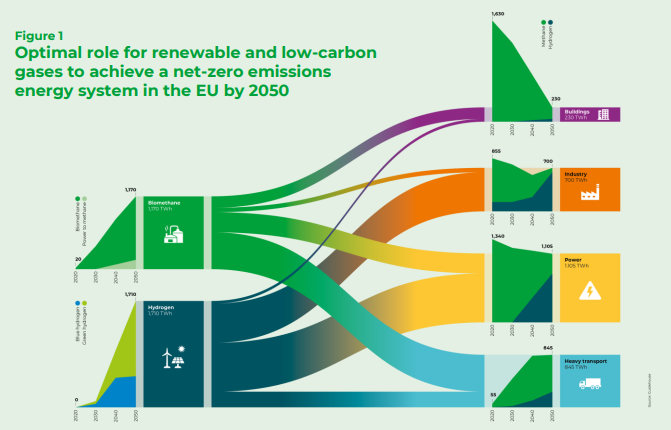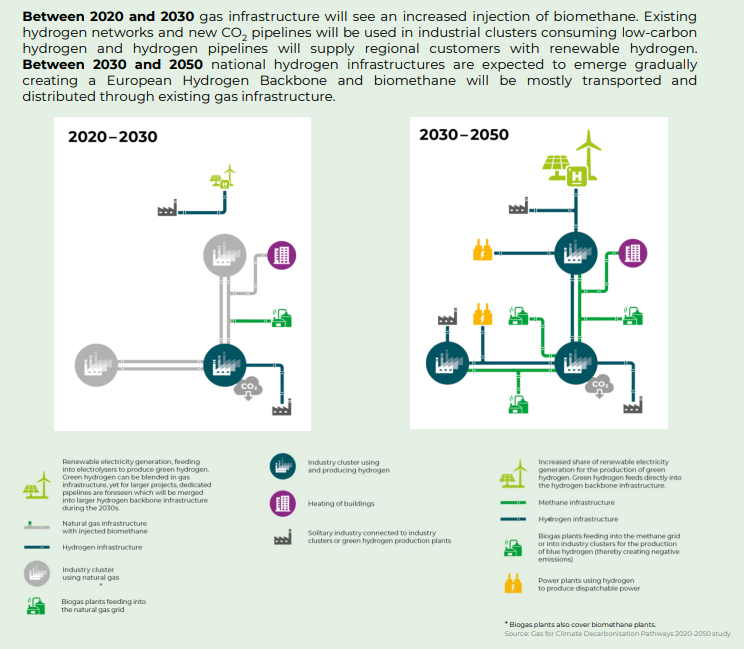Gas for Climate welcomes the revision of the TEN-E regulation and its aim to align TEN-E with the EU’s evolving energy system and its energy and climate targets. Previous Gas for Climate studies have shown the potential of renewable and low-carbon gases to support the full decarbonisation of the EU energy system at the lowest societal costs [1] of the TEN-E regulation[2] as published by the European Commission on 15 December 2020, in particular the opportunities for the creation of dedicated hydrogen infrastructure (newly built and/or repurposed) and of smart gas grids to enable the scale-up of biomethane, renewable and low-carbon hydrogen in the gas grids. With the objective to assist the European Commission in developing the most effective regulation possible, this paper raises a number of points where Gas for Climate thinks the Commission’s proposed revision of the TEN-E regulation could be further clarified and strengthened.
PCI eligibility of hydrogen and smart gas grids in the 6th Union list and timely access to funding
Gas for Climate confirms the importance of ensuring that hydrogen and smart gas grid projects are considered for PCI eligibility in the 6th Union list in order to enable timely investments and achieve the ambitious 2030 and 2050 EU climate targets. It is equally important that candidate projects for PCI status under these new infrastructure categories are able to benefit from a short and fast permitting procedure as well as from a timely access to CEF funding for both studies and works. To this end, it is necessary to clarify how projects under the ‘hydrogen’ and ‘smart gas grids’ categories will be evaluated for their inclusion in the 6th Union list.
Speeding up repurposing of gas pipelines to transport 100% hydrogen
The inclusion of a specific ‘hydrogen’ infrastructure category in the TEN-E regulation will contribute to creating a dedicated pan-European hydrogen infrastructure. In addition, the identification and proposal of regional candidate projects to PCI lists by Regional Groups will continue to be important in supporting the realisation of a regional and eventually European hydrogen pipeline transport network. This requires investments in repurposing existing natural gas infrastructure to transport and store pure hydrogen and in new dedicated hydrogen infrastructure, including storage, as part of the dedicated hydrogen category.
Gas for Climate calls for including the investments directly linked to the repurposing of existing gas pipelines to be ‘hydrogen-ready’, i.e. the capability to operate with 100% hydrogen, in the ‘hydrogen ’category. This means that gas infrastructure companies should be allowed to make the existing grid ‘hydrogen-ready’ within the regular reinvestment cycles, even if the infrastructure will only be used for pure hydrogen transport at a later moment in time (still well before 2050). Only the share of the investment costs associated with ‘hydrogen-readiness’ that enables the infrastructure to transport pure hydrogen would be eligible to access CEF funding.
The EU has set an ambitious offshore wind target of 300 GW by 2050[3]. Dedicated hydrogen production facilities and hydrogen transport infrastructure have the potential to play an important role in the integration of such large amounts of renewable energy and in the development of offshore grids. In line with the EU’s Energy Sector Integration strategy, Gas for Climate proposes to jointly organise an integrated offshore electricity and hydrogen network as well as investment plans to ensure a well-integrated and more efficient EU energy system.
Clarifying and broadening the ’smart gas grids’ category
Gas for Climate has recently published a Policy paper[4] calling for an 11% binding target for renewable gas in the EU’s total gas consumption by 2030, as part of the EU Renewable Energy Directive. Scaling-up distributed biomethane production will be facilitated by increased possibilities to inject biomethane into gas distribution and transmission grids.
[1] 1 Gas for Climate, 2020. Gas Decarbonisation Pathways 2020-2050. See: https://gasforclimate2050.eu/?smd_process_download=1&download_id=339
[2] 2 European Commission, Proposal for a Regulation on guidelines for trans-European energy infrastructure and repealing Regulation (EU) No 347/2013, COM(2020) 824 final. See: https://ec.europa.eu/energy/sites/ener/files/revised_ten e_regulation_.pdf
[3] 3 European Commission, An EU Strategy to harness the potential of offshore renewable energy for a climate neutral future, COM(2020) 741 final. See: https://ec.europa.eu/energy/sites/ener/files/offshore_renewable_energy_strategy.pdf
[4] 4 Gas for Climate, 2021. 2021 Setting a binding target for 11% renewable gas. See: https://gasforclimate2050.eu/?smd_process_download=1&download_id=63


Gas for Climate therefore supports the timely inclusion of a new ‘smart gas grids’ category that includes all required developments enabling the integration of biomethane and of renewable and low-carbon hydrogen in the EU’s energy system. In addition, technological upgrades of existing capacity to blend higher shares of renewable and low-carbon gases are a sensible option to include, depending on regional factors and during an initial transitory phase, as means to support the nascent renewable and low-carbon gas market up to the early 2030s.
The ‘smart gas grids’ category needs to be broadened in scope to better reflect the variety of investments that make up a smart gas grids project. All the necessary investments in grid assets and equipment that contribute to the decarbonisation of the gas sector by enabling the integration of renewable and low-carbon gases should be eligible for PCI status. This includes, but is not limited to, investments in compressor stations, gas analysers, mixers and filtering equipment, equipment that enables and manages injections of biomethane and hydrogen blends, installations and equipment that facilitate reverse flows between the distribution and the transmission networks and any required reinforcements to existing grid assets for that purpose, both upstream and downstream. As rightly included in the Commission’s revision of the TEN-E regulation, the deployment of innovative digital solutions that support the smart management, smart operation and quality requirements of increasingly complex gas and hydrogen grids will become a growing necessity. However, these solutions should be accompanied by all the other investments needed for the integration of new gases.
The definition proposed in Annex IV of the TEN-E revision on the significant cross-border impact that smart gas grid projects need to comply with needs to be further clarified.
- For instance, given the regional and decentralised nature of biomethane production facilities, often located near the distribution grids, it needs to be ensured that the cross-border criterion will not limit the number of projects that could be deployed and could contribute to the decarbonisation of the EU’s gas sector.
- Furthermore, projects blending hydrogen with natural gas at the distribution level, far away from an international border, should also be taken into account. The cross-border criterion, as currently defined in the revision of the TEN-E regulation, would also be difficult to meet in this case and the projects’ benefits to the wider pan-European energy system could be underestimated.
Making the non-physical cross-border impact measurable would be beneficial to bring the integration of renewable and low-carbon gases to its full potential. Gas for Climate proposes to measure the cross-border impact of smart gas grid projects in the context of the criteria and indicators defined in the regulation specific to the ‘smart gas grids’ category by using quantifiable indicators based on ENTSOG’s CBA guideline for project assessments. In other words, a smart gas grid project should be considered to have a significant cross-border impact if the specific project assessment and the corresponding network and market modelling results reflect a net positive contribution of the project to the wider EU energy system. To define this net positive contribution, the project could, for instance, carry a positive impact on the reduction of gas supply costs and on the convergence of prices between EU market areas, as well as on the reduction of the EU’s import needs or on the reduction of CO2 emissions thanks to the integration of more renewable energy sources to the system. Contributing to enabling the switch of fuels from fossil energy sources to renewable and low-carbon gas in carbon-intensive EU market areas could also be part of assessing the positive impact of smart gas grid projects.
The Commission’s revision of the TEN-E regulation establishes specific objectives in the form of a minimum number of PCIs to be implemented by 2026 for hydrogen, offshore grids and smart electricity projects. The role of biomethane in the decarbonisation of the EU’s gas sector is an important one as well that should not be overlooked. Gas for Climate calls for promoting similar levels of commitment for biomethane alongside other decarbonisation options and infrastructure categories under the TEN-E regulation. The EU’s energy system and broader EU economy would highly benefit from this renewable gas that can be produced within the EU’s borders, that contributes to the decarbonisation targets and to the achievement of a more integrated energy system, as well as to the promotion of the circular economy and to the improvement of waste management. Gas for Climate therefore proposes to establish a similar additional performance indicator for the proposed ‘smart gas grids’ category to monitor the progress and achievements specific to the deployment of smart gas grid projects that aim to integrate biomethane and low-carbon gases into the EU’s energy sector.
Inclusion of CO2 storage facilities and transport infrastructure for CCU under the CO2 infrastructure category
Gas for Climate welcomes the (continued) support to developing carbon dioxide transport infrastructure as a key enabler of low-carbon hydrogen and of negative emissions, which will be needed in combination with strong emissions reductions to achieve net zero, by combining biomethane with CCUS. Biomethane-derived hydrogen production in a steam reformer, for instance, combined with CCUS has the potential to achieve the net removal of carbon dioxide emissions of biogenic origin. Carbon dioxide infrastructure also enables the reduction of process emissions from
the cement and lime industries.
In this regard, Gas for Climate highlights the need for policy support for CO2 infrastructure (transport, including maritime, and storage) to help close the loop in the value chain of avoided or negative CO2 emissions and allow for the full realisation of the infrastructure’s potential. This could be done by national policy instruments, such as Carbon Contracts for Difference, to bridge the financial gap between the current ETS price and the strike price. Including both CO2 storage and transport infrastructure for CCU under the scope of TEN-E could also be considered. The inclusion of CO2 infrastructure (transport and storage) under TEN-E would help de-risk the early deployment stages of these technologies until economies of scale are achieved and public financial assistance becomes less necessary. Acknowledging that carbon dioxide utilisation technologies fall more closely under the context of industrial applications than under the category of energy infrastructure, Gas for Climate proposes that only the part of the infrastructure enabling the direct connection from a carbon dioxide transport backbone to an industrial facility that would utilise carbon dioxide in CCU applications is considered eligible for PCI status.
Gas for Climate would welcome the opportunity to discuss this position paper with stakeholders in the energy sector.
To see more : https://gasforclimate2050.eu/wp-content/uploads/2021/04/A-Gas-for-Climate-response-to-the-proposed-TEN-E-revision.pdf
